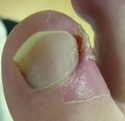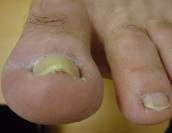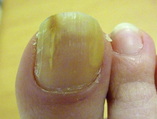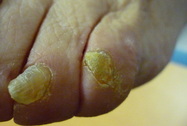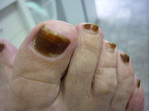Nail Problems of the feet
Deformities and diseases of the nails are fairly common and are referred to as onychosis. It is generally recommended that people with such nail problems should avoid pedicures by beauty therapists unless they have been advised otherwise by a podiatrist or doctor.
Some of the most common nail complaints seen include:
Some of the most common nail complaints seen include:
Ingrown toenailsOnychocryptosis (ingrown toenails) is where a small nail spike or tear on the side of the nail pierces the skin leading to pain and infection. This normally occurs along the sides of the nails from improper nail cutting techniques or trauma. See Photos
> Ingrown Toenails > Ingrown Toenail Surgery |
Curved NailsInvoluted nails have a higher curvature of the nail than usual. In some cases the curvature of the nail is so severe that the tip of the nail culrs around in a circle leading to pinching of the skin causing pain, discomfort, and infection.
Involuted nails are often painful and can develop into ingrown nails. The tendency for involuted nails often runs in families. Ill-fitting shoes and incorrect nail cutting, particularly cutting down the sides of the nails can aggravate involuted nails. |
Nail FungusOnychomycosis (tinea unguium) is another name for a fungal infection of the toe nails (toenail fungus). This infection is contagious and will often travel from the skin to the nail especial after a trauma has occurred to the nail bed. It can result in discoloration, thickening, chalkiness or crumbling of the nails. Fungal infections in the nails can take on a number of appearances and should be assessed by a podiatrist. It is also important to note, however, that nail scrapings are not always accurate way to diagnose onychomycosis.
> Fungal Nails |
Thickened NailsOnychogryphosis (ram's horn nails) is a general thickening of the nail/nails. It can often occur as a result of injury to the matrix such as dropping a brick on a toe, long term neglect (especially elongated nails), or a number of repetitive knocks such as those that occur with continuous use of poor fitting shoe wear. In addition to increased thickness and curvature of then nail, it may also become discolored with a brown tinge and may grow more quickly of one side than the other. When nails get too thick to cut, you may need regular nail care from a podiatrist to reduce the thickness of the nails and to help trim them back as required.
|
Nail StainsNail polish, chemicals and tobacco can all stain the nails. Nail stains are easy to distinguish between other conditions as the staining will grow out with the nail if the ofending cause is illiminated.
In many cases you may be able to remove the stain it if is limited to the surface of the nails by buffing it off with a nail file. In other cases a small amount of lemmon juice rubbed into the nail may also be effective. The stains in this photo were caused by Potassium permanganate |
Lifting of the NailOnycholysis is the painless separation of the nail from the nail bed. Onycholysis can occur in response to illness, prolonged water exposure, skin diseases such as psoriasis, irritation from chemicals including alcohol, shellac, or nail beauty products, infections such as a tinea (onychomycosis), sunburn in photosensitive people, or the result of injury or repetitive trauma and irritation such as from tight shoes or high heels. In the event of all the nails being affected it can be a sign of iron deficiency or thyroid over-activity. It is also a complication of chemotherapy. Onycholysis should always be tended to as the loose portion of the nail can become a hive of activity for fungal, bacterial or yeast infections which will inhibit the nail from reattaching.
|
|
Onychia is an infection of the matrix (the base of the nail) which often results in pus and lifting of the nail, as well as pain, redness and swelling.
Onychodystrophy is a deformity of the toenails that occurs with chemotherapy (bleomycin, hydroxyurea, or 5-fluorouracil). It can also be accompanied by a discoloration (dyschromia) of the nails, and onychomadesis (see below)
Onychomadesis is the complete separation of a nail from the nail bed. This often occurs after trauma or infection to the base of the nail (the matrix) and has been also known to occur as a side effect to chemotherapy, x-ray treatments and severe systemic illness. The good news is that once the cause is removed, a new nail will often regrow in the old ones place. The bad news, however, is that changes to the new nail may occur such as onychogryphosis and may be accompanied by onychomycosis.
Onychoptosis is the loss of either a part or all of either one or more nails. This can occur following a diseases such as syphilis, fever, trauma or in response to certain medications.
Paronychia is an infection (bacterial or fungal) in the cuticle -the area where the area where the skin and nail meets. Paronychia causes pain, swelling and redness around the nail edge and occur suddenly or gradually over time.
Kolionychia (spoon shaped nails) is when the nail curves upwards to form a spoon like appearance so that if drop of water were placed on the nail it would be held in place such as it would in a spoon. It often occurs in response to an iron deficiency and will often progress from brittle nails.
Subungual Haematoma: A blood blister or bruising under then nail that occurs after an knock or from a number of little knocks to the nail area. improper shoe wear. Common causes of large knocks include dropping things on the foot, kicking things and having your foot trampled on. Examples of repetitive smaller knocks include tight shoes or skiing.
Yellow Nail Syndrome: Yellow discolouration of all of the nails across the entire nail bed that does not grow out with time unlike staining from nail polish.
Nail Polish Stains: If you wear dark polish regularly, you could develop stained nails. Skip the polish for a month and rub lemon juice onto them. If this doesn't do the trick, there maybe something else going on. Nails will only Stain where they have have been exposed to the polish and as such the color should grow out or disappear within a few months of not using polish.
Note: If you are suffering from any of these conditions it might be worth seeking the advice from a podiatrist.
My Nail Have Changed, What might this mean?
In many cases, small changes to the nails are fairly harmless. Below is a list of SOME of the causes behind commonly seen nail changes that may occur.
Brittleness, Pliability and strength in the nails
Related Story's
- Fungal Nails
- Ingrown toenails
- Common Skin Problems
- Podiatrist
- Our Clinics
- Callus
- Medi Spa Treatments
Brittleness, Pliability and strength in the nails
- Brittleness is often associated with excess use of nail polish and removers, iron deficiency, thyroid problems, impaired kidney function, circulation problems, and biotin deficiency or fungal nails.
- Splitting and fraying may be associated with psoriasis and deficiencies of folic acid, protein and Vitamin C.
- Unusual thickness is often associated with circulation problems, a history of trauma (onychogryphosis) and onychomycosis (fungal nails).
- Thinning nails and itchy skin may be associated with lichen planus.
- Clubbing, or nails that curve down excessively around the fingertips is often associated with oxygen deprivation and lung, heart, or liver disease.
- Spooning (kolionychia - see above) or nails that grow upwards is often associated with iron or B12 deficiency.
- Pitting of the nails is associated with Psoriasis or trauma
- Grooves along the nail are often associated with kidney disorders, aging, and iron deficiency.
- Beading is often associated with rheumatoid arthritis.
- Ridges across the nail (Beau's lines) may indicate stress or a period of sickness where the nail has slowed or ceased growth for a short time.
- Flatness can indicate a B12 vitamin deficiency or Raynaud's Disease.
- Excessive ridges along the nail are often associated with arthritis.
- Short small beds are often associated with heart disease, but are usually just genetic.
- Paleness or whitening is often associated with the cold, or with liver disease, kidney disease or anemia.
- Yellowing of the nail bed may associated with staining, chronic bronchitis, yellow nail syndrome, lymphatic problems, diabetes, or liver disorders.
- Brown or copper nail beds are associated with arsenic or copper poisoning, local fungal infections or staining such as from tobacco
- Grey nail beds are often associated with arthritis, edema, malnutrition, post-operative effects, glaucoma or cardio-pulmonary disease.
- Blue nail beds are (much like blue skin) associated with poor oxygenation of the blood or cold temperatures. Such causes of decreased oxygenation may include asthma, emphysema, peripheral vascular disease, or cold feet such as that from Raynaud's Disease
- Redness is associated with heart conditions, infection, irritation or simply just warm toes.
- Yellow or Brown toe nails: The most common cause of yellow discoloration in the toenails is a fungal infection. The fungus often develops underneath the nail in the nail bed, resulting in it becoming thick, raised, and yellow in color. These nails may also have an odour when cut.
- Other potential causes for yellow discoloration of the nail include diabetes mellitus and lymphedema (chronic leg swelling). Yellow staining of the nails can also occur in individuals who use nail polish or tan their legs. Stains of the nail plate (not the nail bed) can also occure with discolouration smoking, or henna use. A stained nail may take several months to grow out.
- Small white patches are known as leukonychia punctata.
- Terry's nails are opaque white nails with a dark band at the fingertip, and often associated with cancer, cirrhosis, congestive heart failure, diabetes and aging.
- White lines across the nail (leukonychia striata, or transverse leukonychia) may be Mee's lines or Muehrcke's lines
- Melanoychia (longitudinal streaking that darkens or does not grow out), especially on the thumb or big toe, is usually fairly harmless however in some cases it may indicate subungual melanoma and should always be checked out with a health care professional.
- Dark nails maybe associated with B12 deficiency .
- Red skin at the base of the nail may be associated with infection (paronychia- as above) or connective tissue disorders.
- Blue lunulae is often associated with silver poisoning or lung disorder.
- Receded lunulae (fewer than 8) may be associated with poor circulation, shallow breathing habits or thyroid mysfunction, however in many people thats just the way their nails are.
- Large lunulae (more than 25% of the thumb nail) are often associated with high blood pressure.
Related Story's
- Fungal Nails
- Ingrown toenails
- Common Skin Problems
- Podiatrist
- Our Clinics
- Callus
- Medi Spa Treatments
Contact Us |
Services |
Foot Conditions |
|

